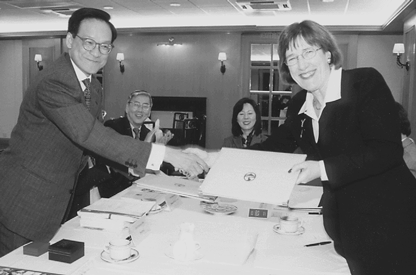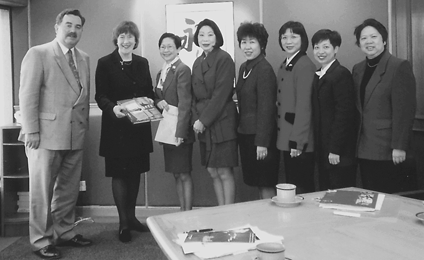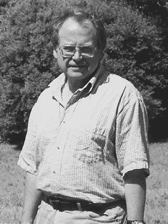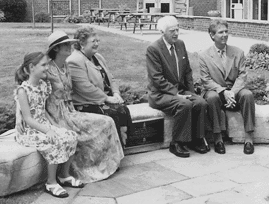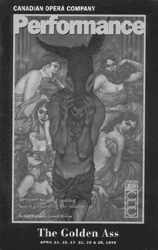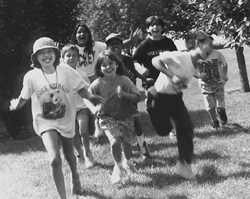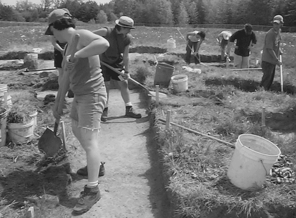 |  |
| | |
| | VOLUME 29, NUMBER 35 | WEDNESDAY, JULY 21, 1999 | ISSN 1199-5246 | | |
| | ||
|
|
By Paul Delany The exploration of our Solar System with automated space probes has been occurring for nearby 40 years. Some of the most successful probes have become well known to even the casual space enthusiast: Voyager, Lunar Prospector, Pathfinder, etc. Currently, the Galileo probe is orbiting Jupiter, giving close-up surveillance of that planet and its entourage of moons. The success of this mission led NASA to launch an equally ambitious mission to Saturn: the Cassini space probe and its Titan (large moon of Saturn) entry probe Huygens. The launch of the Cassini probe to Saturn occurred in October 1997. Conversation on the Internet continues at a brisk pace concerning the onboard power source (RTG), some 70 kilograms of plutonium. (Indeed, it is quite interesting to watch this discussion unfold as it is involving far more people than ever before, an indicator of the influence of the Net.) As power relies on the radioactive decay of plutonium to generate heat, which is in turn converted into electricity, this process will operate regardless of the distance the spacecraft finds itself from the Sun. It is thus the only reliable source of power for the Saturn bound space probe. Recall that Saturn orbits the Sun nearly 10 times further than does the Earth. At that distance, solar power will not be able to supply Cassini with sufficient energy to operate the science experiments, radio transmitters, etc. All deep space probes since the mid 1970s (long before the so-called Star Wars era of technology) have used RTGs. As an aside, NASA has used the Internet to great advantage over the last few years, bringing science into the classroom and living rooms around the world. Unlike many organizations, NASA has made a strong and successful effort to integrate the public in their missions. This of course, means that when NASA experiences a loss or mission failure, absolutely everyone knows about it and all the "dirty laundry" gets aired in public. On the other extreme, when NASA gets it right, as in the Mars Pathfinder/Sojourner mission, the public relations dividend is enormous. The controversy over Cassini has spawned both informed and uninformed debate. Many Web sites exist that are woefully inaccurate in their reporting of the "facts". While I do not for a moment suggest that anyone should confine their investigation of this issue to purely NASA sponsored sites (a good place to start though), check carefully the credentials of any site you choose to read. (This advice applies to all sources of information, including the Net, and not just on the topics of astronomy and NASA.) For example, while plutonium is a poisonous substance, when used to power spacecraft the safeguards put in place over the last 20 or more years have proven more than adequate to protect the public from harm. A great deal of research and engineering has gone into the RTGs to ensure that even in the event of a mishap (a very small possibility indeed), humanity will not be compromised at any level. For example, the plutonium aboard Cassini is encased in a very resilient form of glass ceramic that makes it almost impossible for the plutonium to be released into the atmosphere of Earth in the event that Cassini re-entered during its scheduled August flyby. Why is the space probe flying by Earth at all? The reason is because it lacks the necessary energy (speed) to reach Saturn and by flying by the Earth, the probe will be accelerated to the necessary speed for its trek to Saturn. Indeed, Cassini has already been gravitationally assisted by Venus so this flyby will mark the second such maneuver. Such maneuvers are common place these days with NASA. Since the days of the Apollo moon missions, gravity assists have been used to energize and redirect space vehicles. To indicate how good this technology has become, in 1989, NASA flew the Voyager 2 spacecraft within 5,000 kilometers of the atmosphere of Neptune, a planet that is nearly four billion kilometers from Earth. Further, Voyager took nearly 12 years to reach Neptune so to fly the probe so close to planet given the distance and time it had to travel was truly remarkable. NASA is very good at such maneuvers and there is no reason to believe that they will be any less accurate in the Cassini flyby this August. The current trajectory is spot-on target which means that the probe will fly past the Earth at an altitude of about 300 kilometers. As another aside, it is surprisingly difficult to actually hit our planet. It is much easier (more likely) for any space debris to be flung away from the Earth rather than impact upon our planet. Any exploration is entered into at some risk; the trick is to ensure that the risk is understood, minimal and appropriate to the expected return of information. Cassini fits the bill in my opinion so stand by to be amazed (well, in 2004 anyway). Many of you are aware of an astronomy magazine put out by local astronomy and education writer Terence Dickinson called SkyNews. This is a bi-monthly publication that deals with amateur and professional astronomy with a Canadian focus. Amongst the excellent articles within this magazine is one of the best colour star charts available. (Mel Blake's star chart on this page is a fine map but it is unfortunately in black and white and thus loses some information as a result.) The Observatory receives a bulk order of these magazines and we are able to offer a small number of them to the York community at a substantial discount from the cover price. If you are interested in a copy of this magazine, contact me (pdelaney@yorku.ca or ext. 77763) and we can arrange for you to get a magazine for $2.50. Back issues are also available for $1. Clear skies to you all and remember to drop by the observatory on campus any Wednesday evening this summer after 9:00 pm. Prof. Paul Delany is a senior lecturer in physics and astronomy at York University.
| |
|
|
By Nishat Karim Although the weather fluctuated all week, the mood of the people didn't. Spirits were high and smiles were in abundance as York celebrated its 1999 spring convocation. More than 5,500 students graduated at York's spring convocation ceremonies, adding to the University's 150,000 strong alumni. The ceremonies began on June 12 and continued through to June 18 on the West Quadrangle Lawn on the Glendon campus and the convocation tent located east of the Centre for Film and Theatre on the York campus. Each year at convocation, friends and family gather together to watch the graduates receive their diplomas. And every year the event begins with the head usher informing guests of the rules and regulations that maintain the orderly fashion of the event. This year, on York's 40th anniversary, Chancellor Avie J. Bennett insisted that things be done differently. Rather than remaining silent until all diplomas had been distributed, he requested that the guests who have helped graduates achieve their goals hoot, holler and applaud as much as they desired during the ceremonies. This request was taken fairly well. In fact, so well that one of the graduates receiving his degree went on stage and shouted "I did it mom!" Another graduate gave Chancellor Bennett and President Marsden each a big hug to share his happiness. But that's not all that was unique to this year's ceremonies. The York University Founders' Society is a new honour recognizing those who made major contributions to York during its founding years (1957-1965). Inductions into the Founders' Society will be made on numerous occasions during the 40th anniversary year. Further information is available on the 40th anniversary home page on the York Web site. The next deadline for nominations is Sept. 8, 1999. During the June convocation ceremonies, the following 17 honorees were awarded membership into the York University Founders' Society: Professor Emeritus Albert Tucker first came to York in 1966 as a professor of history and was appointed Chair of the Glendon history department during 1968. In 1970 he became the second principal of Glendon College and was made a University Professor in 1988. Between 1989 and 1991, Prof. Tucker was both a member of the Board of Governors and the Senate Executive Committee. Professor David Bell, one of York's earliest students (beginning his studies at Glendon Campus in 1962-63) graduated with a York First Class Honours Scholarship. Prof. Bell was also the dean of the Faculty of Graduate Studies (1981-1987) as well as dean of Environmental Studies (1992-96). Currently he is the director of the York Centre for Applied Sustainability. When Dr. Jules Heller arrived at York in 1968, he served as the founding dean of the Faculty of Fine Arts and headed a small team of teachers, scholars and artists to develop the interdisciplinary curriculum in the Faculty of Fine Arts. He was also largely responsible for seeing through the development of what is now called the Centre for Fine Arts - one of the campus' most interesting buildings.
Serving as an early registrar of the University from 1962 to 1966, Mr. Donald Rickerd then became the first master of Winters College during the summer of 1967. He also served as secretary of the Senate (1965-
Professor Michael Creal was appointed a professor of humanities in September of 1965. Later he became the Chair of the Division of Humanities, Atkinson College (1965-69), and master of Vanier College (1975-82). Through his membership on the Faculty of Arts and Senate committees for more than three decades, Prof. Creal has made a significant contribution to the development of the University and its programs. Professor Sydney Eisen played a critical role in the development of the Faculty of Arts, and York as a whole. In 1965, he was appointed a professor of history and humanities and served as the Chair of the history department from 1971-72. Later he was appointed the dean of the Faculty of Arts (1973-78). Prof. Eisen continues to serve York by maintaining an active role in York's Centre for Jewish Studies. In 1993 he was awarded a University Professorship. Renowned and distinguished Canadian historian Professor Emeritus Ramsay Cook joined York's Department of History in 1968. He has been a key member and builder of one of Canada's leading history departments for thirty years. Prof. Cook is both a Fellow of the Royal Society of Canada and an Officer of the Order of Canada. Professor Willard Piepenberg, appointed in 1964 as Acting Chair of the Department of History and assistant dean of the Faculty of Arts and Science, served as the associate dean of Arts until 1971. During this time, Prof. Piepenberg established the Faculty of Arts internal forms of governance and its relationship with Senate. In 1987, he was appointed a University Professor. It was during 1963 that Professor John T. Saywell was appointed a professor of history and social sciences. Later, for 10 years, during the period when the University saw unprecedented expansion in student enrollment and faculty hiring, Prof. Saywell was the dean of Arts and Science. When Professor John Yolton joined York University in 1964, he served as Chair of the Department of Philosophy and acting dean of the Faculty of Graduate Studies. Later during 1973, Prof. Yolton served as acting president of York University. On July 1, 1968, Professor Gerald A.P. Carrothers was appointed founding dean of the Faculty of Environmental Studies. As the dean he designed and implemented plans for a new and unique FES. He also assembled the initial FES faculty team and guided the development of the new program. Prof. Carrothers was appointed a University Professor in 1992. Professor Alex Murray was cross-appointed in history and social science when he first arrived at York in 1962. In 1969, he was appointed as a founding member of the Faculty of Environmental Studies and served as the coordinator of the Urban Studies Program, Faculty of Arts from 1968-72. During 1965, Professor Emeritus Harold Schiff was appointed a professor of chemistry and Chair of the Department of Natural Science. He later became the associate dean of the Faculty of Arts and Science in 1966 and the founding dean of the new Faculty of Science in 1968. In 1980, Prof. Schiff was honoured as a University Professor. He is also a Fellow of the Royal Society of Canada. When Professor Denis Smith arrived at York, he was appointed the founding registrar in 1960 and later professor of political science. He also served as a student advisor in 1960-1961 and participated as a member of Senate. Prof. Smith was very committed to York's philosophy and was an early believer in the college system. Professor Del McCormack Smyth has held numerous positions during the early years of York. He was acting dean of Atkinson College during 1963 and at the same time was assistant to the president from 1962-1964. From 1964 to 1969 he was dean of Atkinson College and in 1967, Prof. Smyth became the founding director of the York University Centre for Continuing Education. The Faculty of Administrative Studies, now known as the Schulich School of Business, was founded by Professor James Gillies who was brought to York University in 1965 by York's Founding President Murray G. Ross. Serving as dean of the business school and vice-president of academic affairs until 1972, Prof. Gillies played a significant role in the building of York during its early years and to acknowledge this he was made a University Professor in 1995. As the second female faculty member Professor Emeritus Clara Thomas was appointed a professor of English in 1961 and has remained an active member of the York community. Currently she is the Canadian Studies Research Fellow in the Universities Libraries. Her devotion to her field, to her students and to York were recognized with an Honorary Degree in 1986. Prof. Thomas is also a Fellow of the Royal Society of Canada. On May 31, 1999, two additional members were inducted into the Founders' Society. Founding staff member, Ms. Vicky Draper, started working at York in 1960. In 1969 she was assistant registrar and was responsible for student programs in Arts for many years. When she retired in 1990, Draper was the executive officer in the Office of the Dean, Faculty of Arts. Professor Emeritus C. David Fowle was a professor of zoology and biology in 1957 and became acting Chair of the Department of Biology in 1962. This well known Canadian naturalist and conservationist was appointed the first master of Vanier College in 1966, and was also elected Chair of the York University Faculty Association. Honorary Doctorates were awarded during the spring convocation to exceptional individuals in fields such as education, broadcasting, literature and business (see Gazette issue June 9, 1999). Other awards presented included the Governor General's Gold and Silver Medals, Murray G. Ross Award and the Parents' Association University-Wide Teaching Awards. The Governor General's Gold Medal is awarded to a student graduating from a program in the Faculty of Graduate Studies who has shown the highest distinction in scholarship at York. The Governor General's Silver Medals are awarded to two graduating students in their final year of an honours program who have shown the highest distinction in scholarship at York. This year the Gold Medal was awarded to Jeremy T. Kerr, PhD in Biology and the two Silver Medals went to Sharyn T. Costin, B.A. Honours, Vanier College and Magdalena Dorywalska, BSc Honours, Faculty of Pure and Applied Science. The Murray G. Ross Award is presented to a graduating student at York for scholarship and outstanding participation in undergraduate student life. The scholarship was awarded to Irvin Abrahim Studin, BBA Honours, Schulich School of Business during this year's spring convocation. York also has four categories of annual university-wide teaching awards for excellence in teaching. The categories are senior full-time faculty, full-time faculty, contract/part-time faculty and teaching assistant. Presented during convocation, these awards are sponsored by the York Parents' Association and the recipients are selected by the Senate Committee on Teaching and Learning. During the spring convocation this year, Professor Malcolm Blincow and Professor Lesley Jane Higgins received the senior full-time faculty award. Professor Judith Rudakoff received the full-time faculty award, and the contract/part-time faculty award was presented to Professor Ibrahim Badr. Teaching assistant awards were given to Caitlin Fisher and Jean Noble.
| |
|
|
By Andrew McRae President Marsden with President and Chair Professor of Economics at Lingnan University Dr. Edward K.Y. Chen in Hong Kong. York University has developed a number of initiatives to build and sustain ties with governments and universities in the Far East, in addition to maintaining links with its alumni throughout the region. The York-Meiji University (Japan) Summer Language Program - over 13 years old - has proven a successful venture between the two universities. Meiji also has a Canadian studies program supported in part by the Canadian government. Both Meiji and Keio universities in Japan have signed Exchange Agreements with York that encompass students, faculty and staff. Exchanges are also in place with Kobe and Dokkyo Universities and the International University of Japan. York is anticipating an increased interest in Far Eastern studies. To facilitate this, Founders College is undergoing extensive renovations to accommodate the expanding East Asian Studies Program. Mention the name "York University" in the Far East today and you're likely to receive a nod of familiarity and approval. With the global community becoming increasingly smaller as the millennium approaches, amicable and cooperative relations between universities on opposite sides of the globe can be sustained. Bridging the distance is most sincerely accomplished face to face. York President Lorna Marsden and Vice-President (University Advancement) Gary J. Smith visited Japan and Hong Kong this past winter. Professor Bernard Luk, coordinator of the East Asian Studies Program in the Faculty of Arts was also part of the York contingent in Hong Kong. At the kind invitation of the Governments of Japan and Hong Kong, the York delegation met with government officials, visited university and research institutions, and solidified contacts with York alumni there. Vice-President Smith also visited Singapore for three days of meetings with universities and the Singapore branch of York's Alumni Association.
In her report of the trip to Japan President Marsden wrote: "Clearly, there is much to the mutual advantage of our scholars and students by increasing the exchanges between Japan and Canada....In terms of research, there are many common interests in the areas of security studies, languages, politics, research on gender issues, law and business." In Tokyo, Canadian Ambassador to Japan, His Excellency Len Edwards, gave an official luncheon where the York delegation, among others, met with Ministry of Foreign Affairs Director General Sadaaki Numata; the delegation met with Minister of State for Economic Planning Taichi Sakaiya at a later dinner. One of the main purposes of the Japan visit was to strengthen the relationship between York and a number of organizations in Japan, particularly Meiji and Keio Universities with which York has exchange agreements.
Most Japanese university communities regard Canada's west coast universities such as the University of British Columbia and, increasingly, the University of Victoria, as holding the closest ties with Japanese culture. It comes At Keio University, President Marsden discussed York's interest in peace and security studies. She met with Dr. T. Yamamoto at the Japan Centre for International Relations (JCIE), who shares York's concern for human security. York's Centre for International and Security Studies will benefit from relations with the JCIE. Keio is now building a new centre for research on peace and security, and there exists the potential for expanded exchange in this area. Japan is currently overhauling its education system, making education reforms a hot topic for discussion between the York delegation and the Japanese Ministry of Education. Reforms at the university level, as well as the problems faced by a country with a low birth rate and a tuition-based revenue system for higher education, were tabled. Bringing Japanese higher education closer to that of North America and Europe both in terms of recruitment and in openness to women's studies and women's participation are formidable reform challenges. The number of female faculty is very low in Japan. Since 1975, the government has been working to ensure gender equity and promote gender studies. However today, few Japanese universities offer gender studies, and women in senior administrative positions are seldom found. Nor is there a consciousness of the role of women in the economy in university communities. As a result of the trip to Japan, two alumni, Mr. Allan Dwyer and Dr. Toru Yoshikawa, took the leadership role in forming a branch of the York University Alumni Association. The branch is in its infancy as it looks to form an executive and plans its first official event. The current Japanese Diet (legislative assembly) is debating a basic law for reform that will expand opportunities for women. In spite of such measures, change is still uncertain. Eating habits changed from sushi to sweet and sour dumplings as the York delegation left Japan for the city of lights on the southern Chinese mainland. The objectives of the Hong Kong visit were to visit universities and colleges where York has a special relationship, and to meet with York alumni. Moreover, the delegation wanted to see first-hand the new Hong Kong leadership since the handover, and learn more about the new constitutional, economic and political arrangements. President Marsden signed an exchange agreement with Hong Kong University (HKU) through its Vice-Chancellor Professor Y.C. Cheng. The whirlwind tour proceeded to Lingnan College in the New Territories. This small, residential college plays host to two York graduates working as English tutors. A further agreement was signed with that college to expand the tutor program. At the Chinese University of Hong Kong, ideas for enhancing university exchanges were shared. Over 1,350 York graduates work in Hong Kong today, with the majority hailing from the Schulich School of Business. One member of York's Board of Governors, Mr. William Chan, resides in the special administrative region of Hong Kong. The exclusive Bankers Club was the venue for an alumni dinner hosted by York's Alumni Association in Hong Kong. The Canadian Consul-General to Hong Kong, Mr. Colin Russel, and Chan were two of the many who turned out for this special event; such events solidify the bond between members of the York family scattered across the globe. Singapore was an additional three-day port of call for Vice-President Smith. In addition to being a major world trade and financial centre, it serves as an important regional hub for exchanges between Asian universities. Meetings with the York Alumni Association in Singapore were a top priority, as its membership is particularly strong. Currently, over 300 York graduates are registered in the Singapore Branch of the Association, with an estimated 1,000 more unregistered and working in the area off the coast of the Malay Peninsula. Smith also assisted in the organization of the Canadian Education Centre recruiting fair on Jan. 31. The campaign to attract Singapore secondary school graduates to York is now well on its way as a result of this visit. The number of Singapore students studying at York has declined steadily since 1983. In that year, a record 145 students were enrolled at York; in 1991, 110 students; in 1998, only 17 students. The reason for this is two-fold. With the cancellation of York's Winter/Summer session, which ran from January to August, Singapore students opted to enrol at other universities as their secondary school year ends in December. Increased competition from other institutions - particularly in Australia - has also attracted potential Singapore enrollees. Decreasing numbers of Singapore students at York is discouraging. Laying the groundwork for relations with the Singapore Government is therefore crucial. "In Singapore...the government helps finance a lot of the students who go abroad. It was important that they be made aware of York's existence and our strengths...particularly in the Schulich School of Business, fine arts...and environmental studies," Smith said. Building bridges in previously unchartered territory, and reviving old relationships, was York's successful mission to the Far East. These relationships are and will be beneficial to both York and its foreign counterparts.
| |
|
|
By Cathy Carlyle York's Peter Taylor, professor of atmospheric science and applied mathematics, was presented with the 1998 Patterson Distinguished Service Medal in June at the Canadian Meteorological and Oceanographic Society Congress in Montreal. The medal, which has been awarded annually since 1954, is considered the pre-eminent service award recognizing someone who has made outstanding contributions to work in the field of meteorology in this country. Taylor is recognized as a careful and innovative modeller of the atmospheric boundary layer. His great contribution to meteorology is evident through his involvement in education; his co-editorship of the international scientific journal, Boundary-Layer Meteorology; and his first-class research work, said Gordon A. McBean, assistant deputy minister of the Atmosphere Environment Service, when he awarded the medal. In particular, he cited "The Askervein Hill Project", a study Taylor undertook with an international team of researchers in the mid 1980s on the island of South Uist in the Outer Hebrides of Scotland. He and fellow researchers chose Askervein Hill to meet the criteria of strong winds, a hill covered with nothing higher than bushes, and a place that was somewhat accessible to those conducting the research. Fifty towers were raised and fitted with anemometers for wind measurement, 13 of which were instrumented for turbulence measurement in particular. "The main objective of that study was to increase our detailed understanding of the boundary-layer flow over relatively low hills, especially as it related to wind energy conversion systems," said Taylor. "At that time in Canada there was a lot of interest in wind-generated electricity. It was known to be an ecologically sound way to make electric power and, with increased oil prices, appeared economically viable. Interest in wind power in Canada generally waned after that but expanded considerably in Europe. "At the present time, though, private suppliers of 'green' power want to know if it is feasible to make large amounts of electricity in Ontario that way, after the changes at Ontario Hydro. The Ontario Government's Bill 35 deregulated electricity generation and sales last October, so that private companies or individuals can purchase power directly from suppliers. Groups such as the Toronto Renewable Energy Group are considering the installation of wind turbines on the Lake Ontario shoreline to supply 'green' power to the grid. Similar plans have been implemented in Alberta and Quebec." Taylor said that the results of the project also helped scientists to understand better the stress that wind and turbulence put on hilltop structures such as microwave towers and wind turbines, and to improve their ability to estimate flow and turbulent dispersion of air pollutants in a complex terrain. A project he currently is working on is the study of the effects of blowing snow in the lowest few metres of the atmospheric boundary layer. This layer stretches from earth's surface to between 200 metres and 2 kms, depending on the time of day. "Strong winds, 25 km per hour and more, can pick up snow and carry it. When it's in the air, the snow sublimates, and this can lead to a significant loss of the mass of snow," said Taylor. "It can have an effect on the heat and water budgets of places such as the Antarctic, Arctic and the Canadian Prairies. Large, crop-producing regions like the prairies often cannot afford to lose significant amounts of ground moisture." Weather of all natures interests Taylor. He has carried out research on Atlantic winter storms, installing and operating weather stations near Halifax, Nova Scotia and on Sable Island. "After the 1982 sinking of the oil rig Ocean Ranger in that general area," he said, "we wanted to look at the way storms developed. We tracked the movements of surface cold and warm fronts and low pressure centres and observed their detailed structure." Since 1997 he and his graduate students have been involved in an AES-led project on the "Effects of Lake Breezes on Weather" (ELBOW), studying the role that winds from the lakes in the southwestern Ontario peninsula play in triggering convection and influencing air quality. "In the daytime, lake breezes flow from the lakes inland for 40 kms or more," said Taylor. "This is reversed at night. The peninsula between lakes Erie and Huron is particularly interesting in the way the lakes cause air circulations, making a strong impact on severe weather and air quality. When lake breezes from Erie and Huron converge, they can trigger storms to develop. Also, at lake breeze fronts the increase in the vertical mixing can cause air pollution to be brought down from above the boundary layer to the surface." Taylor continues to be active in research and in national and international groups promoting atmospheric science and, at present, he is vice-president of the Canadian Meteorological and Oceanographic Society. He recently returned from delivering a series of lectures at the University of Coimbra in Portugal and from a research visit to the National Centre for Atmospheric Research in Boulder, Colorado. In his acceptance speech he noted that, "Awards of this type come about because someone, in this case Keith Aldridge and Karen Cunningham, takes the trouble to put together a convincing nomination; and because the candidate has, over the years, been fortunate enough to work with many productive students and collaborators.".
| |
|
|
Adam receives honorary doctorate Dr. Dyane Adam, until recently principal of York's Glendon College and, as of August1999, Commissioner of Official Languages for Canada, received an honorary doctorate in June at the University of Moncton convocation. She was lauded for her political service to the Francophone minority and for her university career as a professor of psychology and an administrator. Bowman waltzes off with two more music awards It's hard to know what title to give Rob Bowman. Loosely, he's been called "Rock-and-Roll Professor", and that name seems to suit the casual yet knowledgeable man who has, again, won awards in the music field. At York University, Bowman is director of the Graduate Program in Music; professor of music; and pioneer of popular music studies. His recent awards were for the Liner Note and Historical Re-issue categories at the Association for Independent Music conference in Atlanta, Georgia in recognition of his work on a three-CD box set by Booker T. & the MG's, entitled "Time is Tight". The booklet he wrote for the set runs to 20,000 words. The list of his other awards is legion. Grayson gets research award for studies on York students Paul Grayson, director of the Institute for Social Research since 1991, has won the Canadian Society for the Study of Higher Education (CSSHE) Research Award for his unique chronicling of York University students. The award was presented at the Congress of the Social Sciences and Humanities in June at the University of Sherbrooke, Que. Grayson has done statistical analyses of students in such categories as their demographic composition, how they rate their academic programs and instructors, what relationship there is between their grades and later earnings, their success in finding jobs after graduation, how well arts graduates do in securing jobs, and so on. Some of his other inquiries have focused on the value added by the university experience to students' communication, analytical, personal and arithmetic skills. More recently, Grayson has produced a five-university study on how students finance their education, reputedly the first study of its kind conducted in Canada. Lennox appointed acting dean of graduate studies John Lennox, professor of English, has been appointed acting dean of the Faculty of Graduate Studies for one year commencing July 1. Previously he was an associate dean in the faculty from 1996 to 1999. Lennox was the first director of the Robarts Centre for Canadian Studies (1985-88) and director of the Graduate Program in English (1987-1990). Outside the University, he has held a number of executive positions in national and international academic societies, most recently as president of the International Council for Canadian Studies (1995-97). A specialist in the field of Canadian literature, his latest publication is an edition (with Ruth Panofsky) of Selected Letters of Margaret Laurence and Adele Wiseman (University of Toronto Press, 1997). Lennox is also a York alumnus, having graduated with his honours degree in English in 1967. The challenges of graduate studies are ones that he shares with all members of the faculty: working for increased support for students, helping develop new initiatives, maintaining and enhancing the quality of programs through the recruitment of excellent and committed students, and listening to the concerns of students and faculty.
| |
|
|
By Nishat Karim Seated in the memorial garden: from right to left, Robert Ross, Dr. Murray Ross, Susan Shone, Beverley Ross and Madeline Ross (daughter of Robert and Beverley) On June 23, 1999 a befitting tribute was made to an honourable woman. At Glendon College, under the "Breezeway", which is appropriately named for the soft summer breeze that passes through it, the dedication of a memorial garden was made to a remarkable woman - Dr. Janet Ross. Her husband, Dr. Murray Ross, the founding president of York University, along with family and friends, celebrated the woman who helped sow York University's seeds during its early years. Dr. Janet, as she was known, was a passionate gardener. Following President Lorna Marsden's welcoming address, Dr. Janet's children Susan Shone and Robert Ross each took a few minutes to speak about their beloved mother. The two siblings reflected upon their mother's love for spending at least a few hours each day in her garden - from planting the first seeds to looking after her flowers in full bloom. As they each spoke, guests soon realized that they not only referred to their mother's ability in the garden outside their home and cottage, but also to how she wholeheartedly nurtured and tended to York University from its beginnings. Robert Ross recalled a time when his parents would host afternoon tea and dinner parties in their home for students and faculty so that they could get to know them better, on a personal level. Although their mother was not on the payroll, her children remember that she was as much a link to York as their father was. As witnesses of this throughout their lives they found the dedication of a memorial garden to their mother a most brilliant tribute to her life. "I think it's an honour for York to recognize her contribution in this way," said Susan Shone. Dr. Murray Ross spoke proudly about his wife's other lifelong contributions to society. Dr. Janet was among the first women to graduate from medical school at a time when women were not encouraged to seek out a professional career. Dr. Ross spoke about how his wife also helped set the standards for generations to follow. This remarkable woman graduated in a class where only five of the graduates were women while 45 were men. Dr. Ross noted that Glendon College's residence was named after one of Dr. Janet's colleagues - Dr. Marion Hilliard, another extraordinary woman, and recognizing that it is because of women such as Dr. Janet and Dr. Hilliard that medicine has become a respectable profession for women. Following these commemorative words Dr. Janet's family and friends walked to the memorial garden which is located down a short path, just a few steps from the "Breezeway". Dr. Janet Ross, who passed away in March of 1994, will always be remembered by York for her devotion and nurturing of the University community as it continues to grow.
| |
|
|
"Pinning the Tale" Symposium brought scholarly lens to a new opera
By John Court The most exciting new Canadian opera in several decades burst onto the Toronto scene for six world premiere performances in April. It was met with an unaccustomed cultural focus on mythical figures and ancient lore, and also more academic commentary than usual. Here at York a closely allied symposium of marquee classicists and the Canadian Opera Company's general director was conceived, organized and hosted by faculty members of York's Classical Studies Programs. The novelty surrounding The Golden Ass, composed by Randolph Peters of Winnipeg with libretto by the recently deceased novelist Robertson Davies, owes nothing to nihilism or existentialism and even less to postmodern popular culture on outer space or cyberspace. It is firmly rooted instead in the classical traditions, set in second-century Carthage and derived from a Latin novel of that era by Apuleius, originally entitled Metamorphoses. Born in 114 CE at Madaura (modern Madara in Tunisia), a Roman colony near Carthage, Apuleius spent time in Athens becoming a philosopher, rhetorician, poet and, as he also tells us in his famous Apologia, a disciple of all the nine Muses. The parallels between his enthusiasms and those of Robertson Davies are striking: ancient legends and morality tales of supernatural spirits affecting the lives of mortals, magic spells and conjuring tricks, spiritual mysticism, and the plain, old spinning of rollicking good yarns, preferably not at all devoid of love, lust and even bawdiness. If Apuleius was inclined to parody certain of his contemporaries, that device was also fine with Davies, whose tenure over two decades as master of Massey College and his fictional Cornish trilogy were each interwoven with some ambivalence toward professional academics. Thus he took the artistic liberty of introducing two scholarly characters into the opera who don't appear in Apuleius' original. Davies has given us the Carthaginian scholar in act one of The Golden Ass, drawn unsympathetically as a censorious, blue-nosed busybody, and one of the less jolly members of the robber band in the second act who is soon revealed as a disgraced outcast from the academy at Athens. Richard Bradshaw, general director of the Canadian Opera Company (COC) and musical director of The Golden Ass, mentioned during the York symposium, "Pinning the Tale: Apuleius' Golden Ass in its Cultural Context," held at Founders College on April 24th, that Rob Davies' favourite opera was Mozart's The Magic Flute. It contained most of those same elements and, like The Golden Ass, interwove aspects of the cult of worship for the ancient Egyptian gods, Isis and Osiris. (Lest it threaten to take itself too seriously, however, the new opera owes a debt for comic relief in the second act to Gilbert and Sullivan.) Davies, the wealthy scion of a prominent Ontario newspaper family, believed that today's writers should survive (or not) wholly through economic forces, figuratively spreading their rug in the marketplace to tell stories that are rewarded according to their audience reception by coins dropped in the storyteller's bowl. This free market homily is exactly as portrayed in The Golden Ass through the narrator, Festus the Fabulist, who replaces the first person narrative of Lucius in Apuleius' original text. Bradshaw mentioned as well to the York symposium that this opera had been "generously received by the critics, with some reservations about the music being rather too accessible," as though the opera form should make earnest demands on its audience. Peters was reportedly inspired by the libretto to compose accessibly. This production did benefit nevertheless from the COC's regular surtitles feature that buttresses textual communication, usually to provide a translation. Yet the music does bring layers of imaginative expertise to the production that are revealed subtly, and not at a single sitting. Bradshaw disclosed that Pamphilea's mystic incantation of palindromes, "sator arepo tenet opera rotas", was accompanied by an almost undetectable device in the score: a twelve-tone leitmotif from the orchestra that reverses in sync with the palindrome. The York symposium's chief organizer, James Rives, professor of classical studies and humanities, illuminated a number of layers in the original Latin text through his paper, "Philosophy and Cult in the World of Apuleius". Rives proposed that what makes The Golden Ass unusual is that in the original Metamorphoses, Apuleius fundamentally depicted the process of conversion to a cult (in this case that of Isis and Osiris) as if it were conversion to philosophy. Cults provided a means whereby mortals could communicate with, and win approval from, the gods. Philosophy, on the other hand, is the source of wisdom, reason, happiness and personal fulfillment, more inner spiritual than, as with cults, ritualistically overt with practices based on tradition. Hence both the book and the opera treat us to a sort of convergence between cult and philosophy. Rives went on to note that Apuleius was interested in Eastern traditions, especially Egyptian. In Book 11 the cult of Isis and Osiris provides the narrator, Lucius, with release from his sufferings as a much-mistreated donkey, and a place in the afterlife. Rives, who arrived from Columbia University this academic year as the newest member of the Classical Studies Program in the Faculty of Arts, was ably supported in organizing the symposium by his co-organizer Prof. Jeremy Trevett, a specialist in fourth century Athens, who joined the Department of History a few years ago from Oxford. They were assisted by a number of York colleagues including Prof. Jonathan Edmondson of the Department of History and Division of Humanities, a specialist in Roman Spain. Joining Rives as speakers were classicists of renown from Oxford, Scripps College, Princeton and UBC, while audience members also came from near and far. Among those speakers were some household names among York humanist scholars and administrators, notably former Royal Society president Sandy McKay (also a pillar at McMaster) and Prof. Michael Herren, a recent Killam and Guggenheim Fellow who inaugurated and has shepherded the Department of Classical Studies at Atkinson since the 1960s. Others of stature who would normally have been present were away on study trips, among whom were Prof. Virginia Hunter (History, Glendon) and the founding patron of classics in the York curriculum, Prof. Hugh Parry. Another colleague from Parry's founding era is the Roman social historian and papyrologist Deborah Hobson who became master of Vanier College and associate dean of the Faculty of Arts, then returned from Dalhousie in 1997 as York's Vice President of Enrolment and Student Services. A high school classics teacher who was present remarked that the new Ontario secondary curriculum will provide for a distinct resurgence of Latin in the schools, over the upper three years to the OAC level. Latin is already taught with great enthusiasm in many secondary schools, culminating each year in the Ontario Classics Conference, a province-wide gathering of some 600 students. As they reach university level, high school students will have solid classical studies programs as a reason to chose York. These programs now comprise 13 full- and 10 part-time faculty members to be found at Atkinson and Glendon colleges, the Faculty of Fine Arts, and the Division of Humanities and departments of History, Philosophy and Languages, Literatures & Linguistics in the Faculty of Arts. Hugh Parry insisted, from the outset, on this broadly-based representational structure of cross appointments rather than cloistering together within a single department. Doug Freake, Chair of the Division of Humanities, observed that the classics are by nature interdisciplinary, so they have always been a strong enrichment to the division's multidisciplinary approach. Students who graduate from this program frequently continue on elsewhere with creditable distinction. Elena Isayev (Classical Studies '93) was recently named a Fellow of the British School in Rome, a very prestigious post-doctoral honour that is usually reserved for the best British graduate students. Honours of that sort achieved by York classics faculty and students come as no surprise to Adrian Shubert, Chair of the Department of History. He noted that there is a symbiotic relationship between historians of all specialties, ancient, medieval and modern. "Ancient historians have always been here, not because there is no separate department of classics but because they are an integral part of this department - one of its essential elements." For further information on any aspect of classical studies at York contact Director Viola Stephens in Room S576 Ross, (416) 736-2100, ext. 22575 or e-mail vsteph@yorku.ca John Court (Glendon '63), an independent historian and archivist, was inducted on March 26th as one of the inaugural members of The York University Founders' Society.
| |
|
|
By Nishat Karim
It's that time of the year again...time to meet old friends and make news ones. It's time to swim, play ball and have fun. It's time for Summer Sports Camp at York - and this year it's better than ever before. For the first time, all the camps that have been pre "Combining the camps is definitely a step in the right direction. It has allowed me to reach a wider market that I was unable to reach before," says director of the tennis camp and York University's varsity tennis Head Coach Eric Bojesen. The camps which began on July 5 and continue through to Aug. 13 are divided into one and two week sessions for children between the ages of 6 and 18. Each camp either specializes in a sport such as basketball, soccer, tennis or track and field, or combines certain sports such as in the Summer Fun Days Camp and the Multi Sport Camp. According to Tom Gretes, the sports camp coordinator and assistant coach for the York Yeomen Football, the camps offer young people exciting learning opportunities in a variety of disciplines and teach them the fundamental skills of the various sports. "Kids get first-hand experience at being in a university and hopefully it will make an impression on them," say Gretes. "They have a chance to walk around campus, get some physical activity, meet new people and have fun. Overall it's a positive experience and a great way to advertise and expose what York has to offer," he explains. Instruction from University coaches is available for participants at beginner, intermediate and advanced levels. Children are grouped according to age and ability, with a low one-to-six instructor-to-participant ratio allowing them the opportunity to ask questions and interact with coaches. "I think it's a great, well-rounded program," says Rosie Carusi, referring to the new sports camp. Carusi is the fitness and lifestyle program officer for York University and the Summer Fun Days camp coordinator. "It's a great opportunity for kids to explore a creative natural setting with some great coaching behind them." Carusi speaks from both the coordinator's perspective and a parent's perspective, since her daughter participated in the fun days camp last year. Space has been allotted for 400-500 kids in total with 25 to 100 children per camp and according to Gretes, the spaces for the remaining weeks have been filling up very quickly. For more information contact customer service at Tait McKenzie Centre, York University at 416- 736-5184 or by Web site at www.yorku.ca/dept/physed. | |
|
|
The York University Board of Governors recently appointed seven new members beginning July 1, 1999. External Members: Rosemary Campbell, a York alumna (MBA '86), has held a series of senior marketing positions since joining IBM Canada in 1976, with a focus on the public sector. She was based in Atlanta in 1997 as executive in charge of the education sector, and is currently responsible for international sales and operations in Canada, the US and Latin America. She is a board member of the Learning Partnership and an advisory member of the Women in Education Association of Ontario. Felix Chee, also a York alumnus (MBA '79), is executive vice-president and chief investment officer at Manulife Financial, responsible for worldwide investment operations. Since beginning his career with the Development Bank of Singapore in 1972, he has worked at Ontario Hydro (as treasurer and senior vice-president, finance) and with the International Finance Corporation based in Washington, DC. He is a director of the York University Alumni Association. Adèle M. Hurley has been president of her own environmental consulting firm based in Toronto since 1987. She founded the Canadian Coalition on Acid Rain in 1981, served as a director on the board of Ontario Hydro from 1991 to 1995 and was Canadian co-Chair of the International Joint Commission in 1995-96. She is a recipient of the 1990 William Gunn Award from the Federation of Ontario Naturalists, is a trustee of the Walter and Duncan Gordon Charitable Foundation and is the first Canadian director on the board of the North East States Clean Air Foundation, based in Boston. Internal Members: Maurice Elliott is professor and Chair of the English Department in the Faculty of Arts. He joined the academic staff of York University in 1969. He completed a term as Chair of Senate on June 30, 1999, and has previously served as master of Winters College. He was named a University Professor in 1996 in recognition of his exemplary teaching and administrative service to the University. Charmaine Courtis has been involved with York University for thirty years as a student, alumna (BA '72) and employee. She has held increasingly responsible professional and managerial positions and currently is director of Student Affairs and International Relations in the Schulich School of Business. She is the first non-academic employee to serve as a governor. Ross McMillan is a fourth year political science and labour studies student at York University, and is finishing a term as vice-president (academic) with the York Federation of Students. He is also a student representative on the Senate where he served on the Executive Committee and the Academic Policy and Planning Committee. He is also a member of the York University License Board. Honorary Member: Martin Goldfarb, having reached the twelve year maximum as a member of the York University Board of Governors, is appointed as an honorary member. He is chairman of The Goldfarb Corporation, a strategic management company that operates three international businesses. In addition, he is director of Livent Inc., Noma Industries Limited and Axia Multimedia Corporation, and past director of the Canadian Council of Christians and Jews, The Canadian Opera Company, the Toronto Symphony and the Shaw Festival.
| |
|
|
By Michael Todd Every spring, up to 20 York students get together to crawl around the dirt under a hot sun looking for buried treasure. While it's not gold they're looking for, what they find - pieces of chert, pottery, traces of old firepits and post holes - is still valuable to Bob Burgar's eyes. Burgar, an archaeologist, is always eager to uncover more clues to the movement and lives of Ontario's aboriginal peoples. It's hot, dirty work but York students like Isabella Fuschino, a third-year English major (with a minor in anthropology), seems to love it. "This is great experience!" says Fuschino who's got a tan most of us would die for from long hours in the sun. "It's enjoyable, interesting work." Officially, Burgar is supervisor of the joint York University/Toronto Regional Conservation Authority's archaeological digs. While he's employed by the TRCA, the York geography grad. [BA'80,MA'85] is also course director for York's archaeological field school, a full-credit course that students complete in an intensive four weeks. This day we were out at the "Lost Brant" site near Lake Wilcox, but each year York students help excavate another important site, known as "Seed-Barker", south of Kortright Conservation Area on one of the upper branches of the Humber. "Aboriginal peoples almost always settled on or near water or waterways," says Burgar. "It makes sense to find archaeological sites here. People needed water and arable land which was usually found on the flood plains of rivers like the Humber or Don. Rivers were routes from Lake Ontario to Lake Simcoe and points further north like Lake Huron." Burgar says York and the TRCA initially set up the field school for "teachers upgrading their qualifications", but response was so great from students that eventually the course was geared to them. The TRCA's role is to essentially preserve sites "in the ground", says Burgar. "You might think as an archaeologist that I'd be doing the opposite - identifying and digging up as many sites as possible, but that's not the way it works. Our mandate is to identify and document our cultural resources. We usually only excavate a site if we're in danger of losing it to housing or road development or if we need to see whether it, in fact, should be preserved undisturbed." The age of sites in the TRCA's jurisdiction range from about 10,000 BC to 500 AD, says Burgar. "The last people at the Seed-Barker site probably left somewhere around 1520-70." Burgar says sites usually come to his attention because of farming. "Plowing turns up artifacts," he says. To prepare a site for a student dig, it's first replowed, then surveyed and staked out in metre or two-metre "squares". Each student excavates one or more squares a day, digging down a few inches at a time until eventually they're square is about a foot deep. All the soil is placed in a bucket and then carefully sifted (the way you'd sift flour) through metal screens that catch any fragments of bone, pottery or chert. For Burgar, the work is a glimpse into a people and way of life long disappeared: "What we have here is a record of 10,000 years of human culture." | |
| | Current Issue | Previous Month | Past Issues | Rate Card | Contact Information | Search |
|

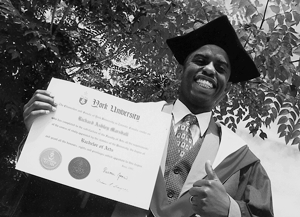
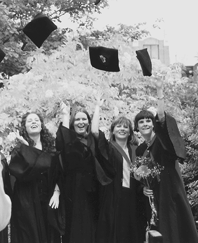 68). Currently he is an associate of the Centre for Refugee Studies.
68). Currently he is an associate of the Centre for Refugee Studies.
